Three ways to build a butterfly spread

A butterfly spread is appropriate when you expect that the price of the underlying asset will remain relatively unchanged and reach a specific target price upon expiration of the options used in the strategy. The following graph illustrates such a situation with shares in BCE Inc., when their price fluctuated within a range of $57 to $59 from November 15, 2016 to March 17, 2017.

There are three ways to build a butterfly spread: solely with call options, solely with put options, and combining call and put options (called the mixed butterfly spread). We will now compare these three butterfly spreads using our example, in which the markets closed on November 15, 2016 with BCE trading at $57.88. Building a butterfly spread generally involves buying an option with strike price X1, selling two options with strike price X2, and buying one option with strike price X3, where X3 > X2 > X1. Furthermore, the spread between X3 and X2 must be equal to the spread between X2 and X1. This procedure is valid for each of the three cases analyzed below. Note that we will use options expiring on February 17, 2017, since the March 17, 2017 expiration was not available on November 15, 2016.
Butterfly spread using call options
Profit and Loss Diagram of the Butterfly Spread Using Call Options
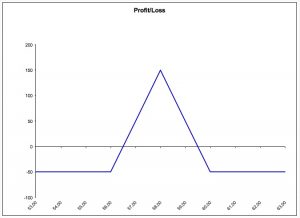
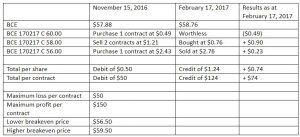
Butterfly spread using put options
Profit and Loss Diagram of the Butterfly Spread Using Put Options
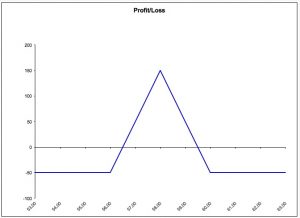
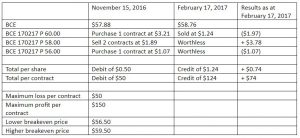
Mixed butterfly spread
November 15, 2016 (February 17, 2017)
BCE = $57.88 ($58.76)
Purchase one BCE 170217 C 60.00 at $0.49 ($0.00), for a debit of $49
Sell one BCE 170217 C 58.00 at $1.21 ($0.76), for a credit of $121
Sell one BCE 170217 P 58.00 at $1.89 ($0.00), for a credit of $189
Purchase one BCE 170217 P 56.00 at $1.07 ($0.00), for a debit of $107
Total credit = $154 (total debit = $76)
Profit and Loss Diagram of the Mixed Butterfly Spread
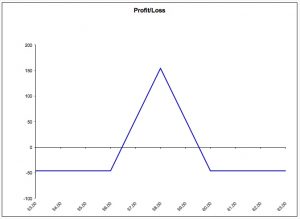
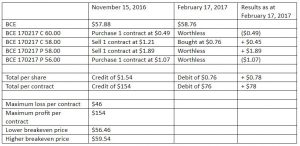
Based on the above evidence, we can confirm that the three strategies have almost the same profit and loss diagrams, even though each is built from a different combination of instruments. As we can see, the butterfly spread takes advantage of the relative price stability of BCE, since profits are realized when the price of BCE falls within a range bound by the two breakeven prices and losses are incurred when its price falls outside of this range, either above or below. On expiration on February 17, 2017, BCE closed at $58.76, so the results of each strategy are as follows.
Results as at February 17, 2017
BCE = $58.76
Butterfly spread using call options
Initial debit = $50, credit on expiration = $124, net profit = $74
Butterfly spread using put options
Initial debit = $50, credit on expiration = $124, net profit = $74
Mixed butterfly spread
Initial credit = $154, debit on expiration = $76, net profit = $78
As we can see, implementing a butterfly spread for the period from November 15, 2016 to February 17, 2017, a period when the price of BCE stayed within a range bound by $57 and $59, generated profits of $74 or $78. All three of these strategies offer similar profitability potentials, so we can use them interchangeably. However, it is worth noting that when using options, particular attention needs to be paid to any dividends that may be paid on the underlying asset. The preceding examples do not take this into account.
Good luck with your trading, and have a good week!
The strategies presented in this blog are for information and training purposes only, and should not be interpreted as recommendations to buy or sell any security. As always, you should ensure that you are comfortable with the proposed scenarios and ready to assume all the risks before implementing an option strategy.
President
Monetis Financial Corporation
Martin Noël earned an MBA in Financial Services from UQÀM in 2003. That same year, he was awarded the Fellow of the Institute of Canadian Bankers and a Silver Medal for his remarkable efforts in the Professional Banking Program. Martin began his career in the derivatives field in 1983 as an options market maker for options, on the floor at the Montréal Exchange and for various brokerage firms. He later worked as an options specialist and then went on to become an independent trader. In 1996, Mr. Noël joined the Montréal Exchange as the options market manager, a role that saw him contributing to the development of the Canadian options market. In 2001, he helped found the Montréal Exchange’s Derivatives Institute, where he acted as an educational advisor. Since 2005, Martin has been an instructor at UQÀM, teaching a graduate course on derivatives. Since May 2009, he has dedicated himself full-time to his position as the president of CORPORATION FINANCIÈRE MONÉTIS, a professional trading and financial communications firm. Martin regularly assists with issues related to options at the Montréal Exchange.
The information provided on this website, including financial and economic data, quotes and any analysis or interpretation thereof, is provided solely for information purposes and shall not be construed in any jurisdiction as providing any advice or recommendation with respect to the purchase or sale of any derivative instrument, underlying security or any other financial instrument or as providing legal, accounting, tax, financial or investment advice. Bourse de Montréal Inc. recommends that you consult your own advisors in accordance with your needs before making decision to take into account your particular investment objectives, financial situation and individual needs.
All references on this website to specifications, rules and obligations concerning a product are subject to the rules, policies and procedures of Bourse de Montréal Inc. and its clearinghouse, the Canadian Derivatives Clearing Corporation, which prevail over the content of this website. Although care has been taken in the preparation of the documents published on this website, Bourse de Montréal Inc. and/or its affiliates do not guarantee the accuracy or completeness of the information published on this website and reserve the right to amend or review, at any time and without prior notice, the content of these documents. Neither Bourse de Montréal Inc. nor any of its affiliates, directors, officers, employees or agents shall be liable for any damages, losses or costs incurred as a result of any errors or omissions on this website or of the use of or reliance upon any information appearing on this website.
BAX®, CADC®, CGB®, CGF®, CGZ®, LGB®, MX®, OBX®, OGB®, OIS-MX®, ONX®, SCF®, SXA®, SXB®, SXF®, SXH®, SXM®, SXO®, SXY®, and USX® are registered trademarks of the Bourse. OBW™, OBY™, OBZ™, SXK™, SXJ™, SXU™, SXV™, Montréal Exchange and the Montréal Exchange logo are trademarks of the Bourse. All other trademarks used are the property of their respective owners.
© 2024 Bourse de Montréal Inc. All Rights Reserved.
